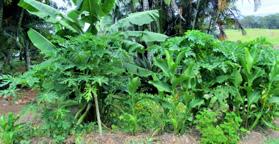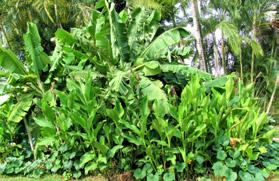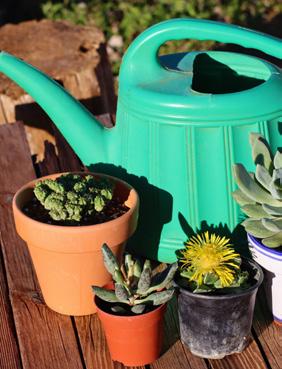
10 minute read
Garden Strategies To Cope With Drought
By Anne Gibson
Australia. It’s hot, bone dry, smokey, and windy across much of this country. Drought and fires have devastated communities with no respite on the horizon. It’s not that these conditions are unexpected, but when all these harsh weather factors occur at once or in succession, the stress and impacts are catastrophic. The prolonged drought conditions have impacted farmers and gardeners on so many levels.
How do you grow crops when rain doesn’t come? Not just seasonally, but for months and years on end? It’s tough on the environment, growers and gardeners, animals and ecosystems, and local economies. The emotional toll and impact on mental health in our communities are substantial. Connecting with several farmers recently in different states, I heard the same story. “We can’t supply our customers. We are waiting for rain. The dam is nearly empty. Even the trees are dying. I’m trying to be brave for the kids.” Heartbreaking reality.

"Devastating" doesn't even begin to describe what is happening in Australia. Months of extreme temperatures and drought have fuelled massive bushfires across the country. Dozens of people have died and thousands of homes have been lost. It is estimated that 10 million hectares of land has burned and over one billion animals have been killed. This is a global crisis that affects us all, no matter where we live in the world.
Grow Your Own
Much of the food bowl of Australia is in dire straits. Recent fires are destroying millions of hectares of bushland, properties, human lives, insects including pollinators, and animals large and small. Thousands of people have been displaced from their homes with massive evacuations. It didn’t take long for food and water to run out. Given most cities rely on essential resources being trucked in, rather than being supplied locally, we’re starting to see the harsh impacts of a non-sustainable food system. Roads blocked due to fires slowed supplies arriving until it was safe. Little comfort if you’re sleeping in a car with your children and pets.
This crisis reaffirmed my conviction; growing at least some of our own food needs in a home garden or community space, supplemented by locally grown produce, is vital to maintain food security. For the majority, we may not ever be genuinely self-sufficient, but learning to be self-reliant with sustainable food gardens can make a big difference. There are many ways we can grow a resilient garden that provides food, medicine, and a sanctuary, even in harsh climatic conditions.
For those lucky enough to have access to town water, this precious resource may have been taken for granted. Turning on the tap and having a reliable watering system for the garden has been easy for some. With drought conditions escalating and water restrictions in place in more cities and towns, this is changing rapidly. Many are reliant on rain to fill tanks or have to buy water. Every precious drop counts. It’s understandable why people give up trying to grow crops or a garden on any scale when the priority is household and animal water needs.
While waiting for the rain to break the drought and relieve these extreme conditions, we can still be proactive by applying a few simple, sustainable habits. So when rain does fall, we’ll be in the best possible position to maximize this precious resource.

Kitchen water from scrubbing potatoes used on leafy greens.
Rethink Water Management Practices

Passive rainwater harvesting with a barrel collection system
1. Practice thoughtful observation. Watch where and how water flows on your property. Start at the top or highest point of entry and take note as water moves downhill. Does it trickle or rush? Is it blocked at some points or move quickly next door? The goal is to slow water down, spread, and sink it into your soil for maximum benefit.
Even if you’re on a relatively flat block, get outdoors during rain and observe the entry and exit points. These are opportunities for passive water harvesting and keeping the valuable moisture on your property to maximize plant growth and collection.
2. Save every drop. Even in the driest climates, it still rains. We often get too little or too much at once, which is not ideal for growing crops. It makes sense to harvest rainwater and store it in the soil and above ground, so you can manage it wisely and spread the load over time.
Outdoor opportunities:
• Locate swales, berms, or raised gardens on contours to soak up and passively harvest water flowing towards them. Plant roots absorb the moisture and slow it down. I’ve used this strategy very effectively in my kitchen garden with three food forest raised garden beds containing numerous fruit trees, perennials, root crops, herbs, and support species.
• Install rainwater tanks to harvest and store roof water so you can redirect it to where it will provide the most benefit. Capture rain in large bins and buckets.
• Use a small container under any air conditioning units to catch drips from condensation that would otherwise be wasted.
• Connect hoses and sprinklers to greywater systems that redirect wastewater from inside the house for use in the garden.
A multifunctional greenhouse to grow food and collect water

A multifunctional greenhouse to grow food and collect water
credit Best Climate Solutions
Indoor opportunities:
• When showering, use a bucket to capture and reuse wastewater on your plants.
• In our subtropical climate, we use a dehumidifier in summer, which collects six liters (1.5 gallons) of water from humid air in a matter of hours! Even better, there’s no fluoride or chlorine found in tap water that can burn leaf tips on some plants, so it’s much safer to use.
• In the kitchen, I fill a large bowl daily with water from cooking veggies, running the tap for various functions, and add cold tea or coffee dregs from cups. There’s often nutrients in this concoction that my plants love!
• When cleaning out dog bowls, flower vases, and fish tanks, tip this nutrient-rich water into gardens for a boost.
3. Conserve the moisture you’ve got. Once you’ve captured rainwater, these strategies can help minimize transpiration from plants or evaporation from soil surfaces:
• Grow ground covers or living mulch such as perennial native grasses and low-water needs plants to cover and shade the soil.
• Add a layer of mulch after rain to lock in the moisture and maintain cooler, consistent soil temperature.
• Add organic matter and compost to your soil. This acts as a sponge, releasing moisture gradually to plants over time. The higher the humus content of your soil, the more water it holds.
• Grow shade traps and windbreaks to protect and filter hot sun and winds from plants. This helps reduce heat stress and transpiration. For example, I’ve found by growing sun-loving fruit trees like citrus on our hot western side of garden beds (southern hemisphere), they create shady microclimates for shade-loving edibles like ginger and turmeric, which I position on the eastern side of the beds. I’ve noticed at least a 5°C (41°F) cooler temperature difference between the beds in the shade!
We may be living with climate extremes for some time to come, so utilizing strategies like these may help your garden survive and even thrive.
There are other ways we can protect our gardens and help them survive through periods of limited rainfall and hot temperatures while providing us with food.

Baby leaf vegetables and herbs can be eaten as nutrient dense microgreens in a fraction of the space and time taken to grow mature plants
Design and utilize microclimates
For the last ten years, I’ve experimented with creating beneficial microclimates and used the ones already onsite to help mitigate moisture loss and protect plants from harsh weather. In hot, dry, and windy conditions, plants tend to lose moisture faster, so designing in more shade and wind protection can help save your garden. Crop covers, shade from buildings and vertical structures can all make a positive difference. Assess the opportunities and threats around your home and note down any places you could improve your design or make changes.

Garden beds can be mulched heavily to feed soil, minimize weeds and retain moisture until it rains
For example:
• Group plants together to increase humidity and reduce transpiration. Use large-leafed, tall plants to help naturally shade small, short ones.
• Cluster drought-hardy plants together to avoid wasting water on mixed plantings. Group thirsty plants in a large pot or zone and water more frequently.
Choose plants wisely
Plants anchor and protect topsoil from erosion and being lost in dust storms. Careful plant selection and timing can minimize losses to drought and heat.
• Food producing edibles tend to have higher water needs than water-wise native plants. This is especially the case for fruiting crops like eggplant, cucumber, melons, and fruit trees. Ideally, locate these in the areas that collect the most moisture or in self-watering container gardens. There’s no point growing them unless they produce fruit! For example, I planted bananas at the lowest end in my kitchen garden on the boundary where water flows down and pools in times of heavy rain. They soak up any available moisture and continue producing fruit even during drought.

My banana and paw paw circle growth after 1 year watering with greywater

Multiple bananas (4 bunches) with paw paws after 2 years utilizing greywater
• Grow robust, drought-hardy herbs and perennials that produce a good harvest with little water. These include rosemary, oregano, aloe vera, thyme, marjoram, lemongrass, savory, chilis, pineapples, and garlic chives.
• Save your water for edibles with higher water needs like leafy greens, mints, and fruiting crops. Many can be grown in self-watering pots, mulched well, and continue producing a harvest.
• Choose heat-tolerant, dwarf and low-waterneeds edible varieties. Many compact cultivars are available that need less space, moisture, and time to mature. For example, I grow tiny Cucamelons (Melothria scabra) instead of large cucumbers. The vine produces bite-sized fruits in a fraction of the time it takes to grow bigger varieties. Lebanese eggplants, banana capsicums, and cherry tomatoes also use less water and produce fruit faster than other cultivars.

Cucamelons (Melothria scaba)

Group drought-hardy plants like succulents together for infrequent watering
Downscale your Garden to Pots
It may be necessary during drought conditions to grow less but still, enjoy a harvest from at least some plants. I save seeds and take cuttings from my favorite edibles, so I have a backup plan to regrow when conditions improve. I leave many of my garden beds to tough it out while carefully selecting other crops to grow in containers close to the house, where they’re easy to maintain.

Drought hardy herbs like rosemary, oregano, garlic, chives, aloe vera are grouped together
These are a few strategies you can use to scale back but still grow fresh ingredients:
1. Put low-value garden zones into ‘maintenance mode’ by covering with mulch or a living ground cover. Instead of growing seasonal crops in garden beds, you can still build your soil and prevent weeds until it rains or more favorable conditions return.
2. Prioritize the most valuable and often needed herbs, salad greens, and edibles you buy regularly. It makes sense to keep these alive if you have to choose between food and ornamentals!
3. Save seeds and grow seasonally appropriate herbs and leafy greens indoors as microgreens or sprouts. With minimal time, water, and space required, these are highly nutritious fresh ingredients that can be grown year-round in any climate in just 7-21 days.
4. Fast-growing water-wise root crops such as round radishes, compact carrot varieties like ‘Paris Market’, and bulbing spring onions add flavor and color to meals and are perfect for pots.
We may not be able to control the weather conditions, but we can still make wise choices about how and what we grow and still enjoy a fruitful harvest.










